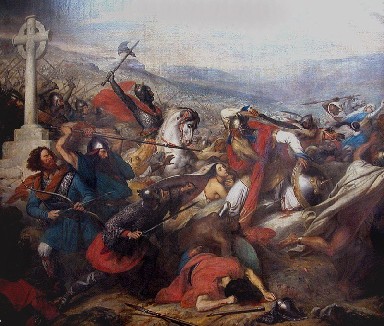Please e-mail me with any additions, corrections, and comments
This site created by Harry E. Connors III
Music is O Fortuna
Pip's Stories
Charles, called Martel or The Hammer, was born on August 23, 688 AD. His father was Pepin of Heristal, the ruler of Austrasia and Mayor of the Palace under the last of the Merovingian Kings of the Franks. Austrasia was a kingdom in the Rhine valley in what is now Germany. Charle was an illegitimate son of Pepin and was imprisoned when his father died in 714. Charles escaped in 715 and was proclaimed Mayor of the Palace by the Austrasians. In the ensuing civil war, Charles not only ended up ruling Austrasia, but neighboring Neustria--now northern France. Charles fought a series of wars in which he was victorius and made himself King of the Franks in all but name. The great crisis of Charles's life, and the battle in which he earned the name "Martel," was the Battle of Tours in 732.

Charles Martel
In the century since Mohammad's death in 632, Islam had spread until the Umayyad Caliphs ruled from the Indus River to the Atlantic. In 711 Berber tribesmen crossed to Spain. By 732 most of Spain and parts of what is now southwestern France were under Umayyad rule. In the spring of 732 Duke Odo of Aquitaine was defeated and, in the autumn of 732, a large Moslem army, composed of heavy cavalry and led by Abdul Rahman Al Ghafiqi, advanced toward Tours where the Abbey of Saint Martin of Tours was the richest and holiest shrine in western Europe.
Charles advanced with a much smaller army composed almost entirely of infantry. At this time, western Europeans did not use the stirrup which was in use by the Umayyads. This was a technical innovation that allowed heavy Umayyad cavalry to rout and destroy armies in Spain and southern France. Charles figured he could only achieve victory by choosing his ground carefully and forcing the Umayyads to attack him over ground unfavorable for cavalry. He managed to achieve complete surprize when the Umayyads discovered his army drawn up in ranks on a wooded hilltop between Poitiers and Tours. The exact location of the battle is unknown and the battle itself is sometimes called the Battle of Poitiers.
The armies faced each other for seven days while the Umayyads gathered their strength. The delay allowed Charles the opportunity to build his strength as well. Charles's army was composed of trained veterans and untrained militia. The militia was virtually useless against the Umayyad cavalry. Charles's hopes for victory were on his seasoned veterans. As the days passed more of those veterans arrived from scattered outposts.

The Battle of Tours. Charles Martel, with the axe, and Abdul Rahman Al Ghafiqi are the central figures.
Traditionally, the Battle of Tours has been considered one of the most important battles in history, the battle that saved Christian Europe and turned back the forces of Islam. Recently, some modern historians have taken issue with that assessment claiming that the Umayyad army was only conducting a raid and that the Umayyad caliphate was to fall in a few years of its own weight. Perhaps, but it is hard to see what could have stopped the Umayyads had it been Charles who died at Tours, and the battle did, in fact, mark the turning point in the long war between Christian Europe and the Moslems.
Charles won several more battles against the Umayyads over the next few years. He, and the Franks, quickly adopted the stirrup which meant that they were never again at such a technological disadvantage. The stirrup allowed for the development of that icon of the Middle Ages, the knight in armor. Charles never actually became king. He was king in all but name. It was left to his son, Pepin the Short, to ask the obvious question, "Who should be king--the man with the crown or the man with the power?" Pepin founded the Carolingian dynasty. Pepin's son, Charles Martel's grandson, was Charlemagne who founded the Holy Roman Empire.
Among the descendants of Charlemagne, and Charles Martel, was an impoverished French noblewoman, Catherine Baillon, who went to New France. Among her descendants were the Robert family of Montreal, Quebec and St. Paul, Minnesota.
This page last modified on Saturday, February 02, 2008